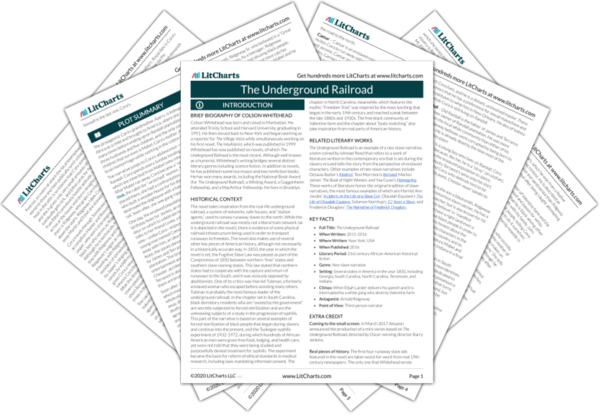Family, Heritage, and Home
The beginning chapters of the book introduce the notion that Cora was predestined to run away because her mother, Mabel, also ran away—running away and pursuing freedom is her family “inheritance.” Although Cora hates her mother for abandoning her to a life of captivity, the penultimate chapter confirms that Mabel believed that by running away she would implant the idea of freedom in Cora’s mind. This lineage of freedom between mother and daughter is…
read analysis of Family, Heritage, and HomeEndurance vs. Rebellion
All the black characters in the novel—whether enslaved or free—must constantly navigate an impossible choice between enduring the brutality of slavery and racism or risking everything in a (likely doomed) attempt to rebel. The entire system of slavery and white supremacy is designed to make black people believe that they have no hope of rebellion, for example by making it illegal for enslaved people to learn to read and write. Similarly, the torture and execution…
read analysis of Endurance vs. RebellionDeath and Freedom
Most of the enslaved people Cora knows—including Cora herself—have never known freedom, and the system of slavery is so brutal and expansive that most of them cannot imagine becoming free during their lifetime. However, Cora notes that even those who would never consider running away still dream of freedom: “Every dream a dream of escape.” Although enslaved people may not be able to consciously imagine freedom, they seek freedom in their unconsciousness. Meanwhile, other enslaved…
read analysis of Death and Freedom
Value, Ownership, and Commodification
Throughout the book, the narrator emphasizes that slavery is an economic system, and that the social and moral behavior of the white characters is fundamentally governed by economic interests. For example, Terrance Randall’s sadistic personality and cruel, lecherous behavior toward Cora is linked with his desire to make Randall plantation as efficient and profitable as possible. Similarly, Ridgeway decides to kill the captured slave Jasper because he calculates that it will be more financially profitable…
read analysis of Value, Ownership, and CommodificationBrutality and Violation
The Underground Railroad depicts the full spectrum of brutality and violation that defined the institution of slavery. Violence is such a large part of ordinary life in the world of the novel that Cora and the other characters are unsurprised by even the most sadistic and gruesome events, such as Big Anthony’s punishment after he is caught attempting to run away. At the same time, Whitehead is careful to show that Cora and other black…
read analysis of Brutality and ViolationHistory, Myth, and Fantasy
The Underground Railroad is a historical novel, and much of what takes place is an accurate representation of what life in mid-19th century America was really like. At the same time, Whitehead also deliberately weaves fantastical and ahistorical elements into the narrative, some of which are more immediately recognizable to readers than others. This decision is a deliberate rejection of the demand that historical fiction realistically and accurately represents the past. By rejecting absolute realism…
read analysis of History, Myth, and Fantasy











